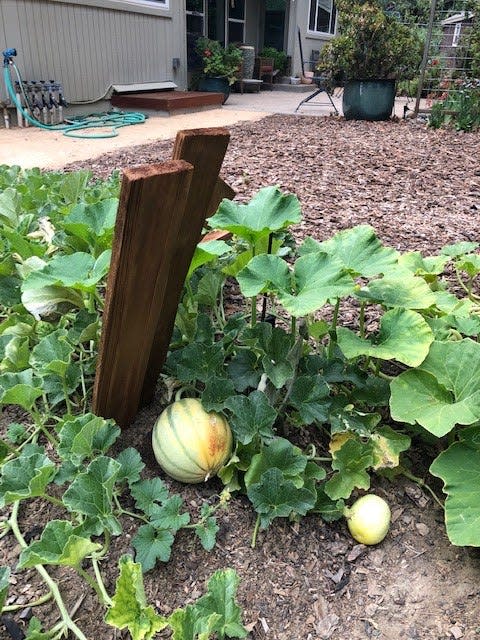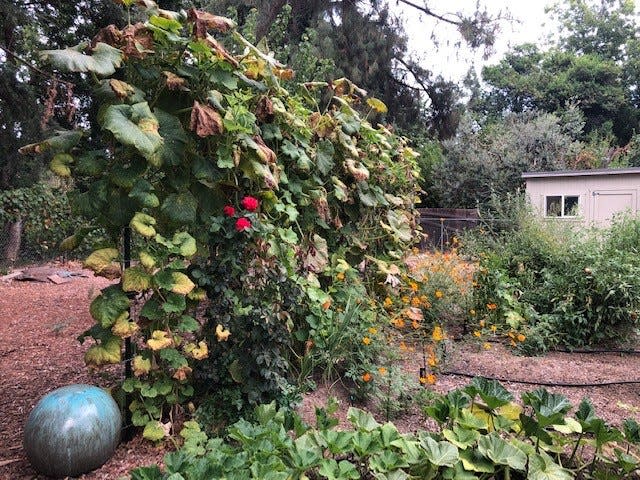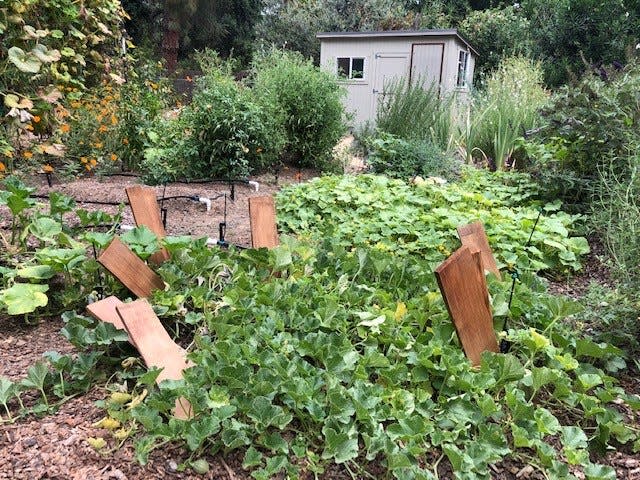Tips to reduce landscape water use during an extreme drought
By now we have all seen the Caltrans signs on the freeways, “Extreme drought — Reduce landscape water use.”
Nevertheless, finding new ways to reduce landscape water use can be daunting. It seems we are being squeezed to the last drop on ideas to help save water. Water managers are wringing their hands, as the state looms over us with data showing our watersheds are not sustainable at the rate we are consuming precious groundwater and surface water.
So, how do we refill our cup full of ideas to see potential savings in our home landscape water use, while still not killing our landscape and gardens by turning the water off? Thankfully, drought is no new subject for University of California researchers.

Know your water use
In summer months, about 50% of your water ends up in the landscape. Most utility bills today will show you how much water you are paying for, though it may be expressed in a hundred cubic feet, not gallons. Find your bill and have a look; UC ANR Publication 8673: "Understanding Your Residential Water Bill" can help you read your water bill: https://anrcatalog.ucanr.edu/pdf/8673.pdf
We are being asked to reduce landscape water use by 15%. So some quick math should give you a number to work with. Mid-summer is a good time to have a walk around your property and check all landscape irrigation for problems, especially leaks.
Tips to reduce water waste
Agriculture and Natural Resources (ANR) Publication 8553: “Keeping Plants Alive under Drought or Water Restrictions” was written in 2015 and is still a good resource to review for ideas on reducing landscape and garden water use: https://anrcatalog.ucanr.edu/Details.aspx?itemNo=8553
“Topics include symptoms of water stress, tips to conserve water in your current landscape, methods to help specific plants survive drought, and considerations and tips regarding planting a drought-resistant landscape.
“Because plants need to be watered before irreversible damage happens, it is crucial to check plants regularly for symptoms of drought,” in which the pamphlet goes on to show pictures of common drought vs. other damage.

Correct sprinkler system problems
Watching your sprinkler system when it is running may prevent plants from being over or under watered. “On average, 20 to 40% of water applied to lawns and groundcovers by sprinkler systems is wasted due to too high rates of application, system leaks, low or tilted heads, broken sprinklers, unmatched sprinklers, and incorrect water pressure and sprinkler spacing.”
Which leads to the next free downloadable resource from UC ANR 8044: “Lawn Watering Guide for California”: https://anrcatalog.ucanr.edu/pdf/8044.pdf
The city of Lodi also has a watering guide online which shows a month-by-month watering schedule for your landscape and garden: https://bit.ly/3zrO4Oo
In the Lodi watering guide, you will notice the seasonal changes in watering needs. For example, August weekly watering times should be a few minutes less than your July watering time, decreasing again in September, as we slowly make our way towards the rainy season, which typically begins in October or November.
Irrigate early in the morning
There are several good reasons for watering in the early morning. Nighttime watering runs the risk of fungal disease developing on wet plants. Late in the day, watering has a higher soil evaporation rate, wasting water.
Recognize your physiological 'wimpy' plants
Some plants are just wimps. It is their way of coping with extreme heat. They wilt in the midday heat and no matter how much water you give them, they cannot absorb available water to compensate, but usually recover by morning.

Avoid summer planting
Fall in the San Joaquin Valley is the best time to add new plants to your landscape, hopefully all drought-tolerant plants. Late August is the best time to begin your veggie garden for fall and winter.
MULCH!
Three to four inches of good quality mulch should be applied and maintained to all your landscape and garden beds. Keep mulch away from tree trunks by at least a foot to avoid soaking trunks, which if wet, will eventually weaken the tree, making it susceptible to diseases.
Gray water system
It used to be a crazy idea, but not anymore with continuous droughts. Most communities in California allow landscapes to use gray water systems. It may pencil out to be cost effective with the cost of water always on the rise. Read more about gray water: https://anrcatalog.ucanr.edu/pdf/8536.pdf
Finally, pray for rain!
Do you have a gardening related question? Contact the San Joaquin UC Master Gardeners at (209) 953-6112. More information can also be found on our website ucanr.edu/sjmg.
This article originally appeared on The Record: How to reduce landscape water use during California drought

